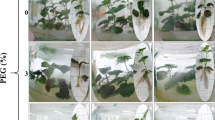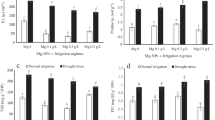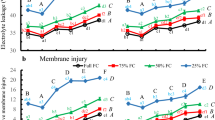Abstract
The effects of three levels of drought stress [100%, 75% and 50% field capacity (FC)] and different concentrations of TiO2 nanoparticles (0, 5, 10, 20, 30, 50, 100, and 150 ppm) were assessed on the different metabolites of Moldavian dragonhead plant, an important ornamental, medicinal and aromatic herb. Results of high-performance liquid chromatography analysis of Moldavian dragonhead extract showed that among 14 detected compounds in the chromatogram, rosmarinic acid was the most frequent and followed by chlorogenic acid, acacetin-7-O-glucoside and apigenin-7-O-glucoside. Drought stress affected some of the metabolites and the highest values of rosmarinic, chlorogenic and p-cumaric acids were recorded in the moderate drought stress (75% FC), while in the higher drought stress (50% FC) some compounds such as caffeic acid and apigenin were increased and some other including ellagitannin and gentisic were decreased. Plant dry weight was also decreased under drought stress while essential oil content was increased. Production of studied metabolites was also influenced by application of TiO2 nanoparticles. Among different concentrations of TiO2 nanoparticles, 30, 50 and 100 ppm showed to be the most effective concentrations. Although TiO2 treatment did not significantly affect plant dry weight, the essential oil content was increased by this treatment and the highest value was obtained after treatment with 30 ppm of TiO2. According to our results, both drought stress and TiO2 nanoparticle treatments are able to increase some valuable phenolic substances including rosmarinic acid and chlorogenic acid in Moldavian dragonhead plant. Altogether, drought stress at 75% FC and TiO2 nanoparticles at concentrations of 30–50 ppm can increase phenolic bioactive compounds of Moldavian balm. New findings possibly would suggest a practical application of controlled drought stress and TiO2 nanoparticles in the culture of Moldavian balm with the purpose of increasing phenolic compounds.
Similar content being viewed by others
References
Amarowicz R, Weidner S, Wojtowicz I, Karmac´ M, Kosin´ska A, Rybarczyk A (2010) Influence of low-temperature stress on changes in the composition of grapevine leaf phenolic compounds and their antioxidant properties. Funct Plant Sci Biotechnol 4:90–96
Burke A, Ito S, Snaith H, Bach U, Kwiatkowski J, Gr¨atzel M (2008) The function of a TiO2 compact layer in dye-sensitized solar cells incorporating “planar” organic dyes. Nano Lett 8(4):977–981
Burke DJ, Pietrasiak N, Situ SF, Abenojar EC, Porche M, Kraj P, Lakliang Y, Samia ACS (2015) Iron oxide and titanium dioxide nanoparticle effects on plant performance and root associated microbes. Int J Mol Sci 16:23630–23650. https://doi.org/10.3390/ijms161023630
Cao G, Sofic E, Prior RL (1996) Antioxidant capacity of tea and common vegetables. J Agric Food Chem 44:3426–3431
Caretto S, Linsalata V, Colella G, Mita G, Lattanzio V (2015) Carbon fluxes between primary metabolism and phenolic pathway in plant tissues under stress. Int J Mol Sci 16:26378–26394. https://doi.org/10.3390/ijms161125967
Chachoyan AA, Oganesyan GB (1996) Antitumor activity of some species of family lamiaceae. Rastitel 32:59–64
Chung IM, Kim JJ, Lim JD, Yu CY, Kim SH, Hahn SJ (2006) Comparison of resveratrol, SOD activity, phenolic compounds and free amino acid in Rehmannia glutinose under temperature and water stress. Environ Exp Bot 56:44–53
Comotto M, Alberto Casazza A, Aliakbarian B, Caratto V, Ferretti M, Perego P (2014) Influence of TiO2 nanoparticles on growth and phenolic compounds production in photosynthetic microorganisms. Sci World J 2014(961437):9. https://doi.org/10.1155/2014/961437
Dastmalchi K, Dorman HJD, Kosar M, Hiltunen R (2007) Chemical composition and in vitro antioxidant evaluation of a water-soluble Moldavian balm (Dracocephalum moldavica L.) extract. Swiss Soci Food Sci Technol 40(2):239–248
De Abreu IN, Mazzafera P (2005) Effect of water and temperature stress on the content of active constituents of Hypericum brasiliense Choisy. Plant Physiol Biochem 43:241–248
Faghih S, Ghobadi C, Zarei A (2017) Response of strawberry plant cv. ‘Camarosa’ to salicylic acid and methyl jasmonate application under salt stress condition. Plant Growth Regul 36(3):651–659. https://doi.org/10.1007/s00344-017-9666-x
Faghih S, Zarei A, Ghobadi C (2019) Positive effects of plant growth regulators on physiology responses of Fragaria × ananassa cv. ‘Camarosa’ under salt stress. Int J Fruit Sci 19(1):104–114. https://doi.org/10.1080/15538362.2018.1462291
Frazier TP, Burklew CE, Zhang B (2014) Titanium dioxide nanoparticles affect the growth and microRNA expression of tobacco (Nicotiana tabacum). Funct Integr Gen 14:75–83
Ghanndi A, Sajjadi SE, Abedi D, Yousefi J, Daraei-Ardekami R (2004) The in vitro activity of seven Iranian plants of the Lamiaceae family against Helicobacter pylori. Nigerian J Nat Prod Med 8:40–42
Gharibi S, Sayed Tabatabaei BE, Saeidi G, Hossein Goli SA (2015) Effect of drought stress on total phenolic, lipid peroxidation, and antioxidant activity of Achillea species. Appl Biochem Biotechnol https://doi.org/10.1007/s12010-015-1909-3
Ghosh M, Bandyopadhyay M, Mukherjee A (2010) Genotoxicity of titanium dioxide (TiO2) nanoparticle at two trophic levels: plant and human lymphocytes. Chemosphere 81:1253–1262
Hernandez I, Leonor A, Sergi M (2004) Drought-induced changes in flavonoids and other low molecular weight antioxidants in Cistus clusii grown under Mediterranean field conditions. Tree Physiol 24:1303–1311
Ibrahim MH, Jaafar HZE (2011) Photosynthetic capacity, photochemical efficiency and chlorophyll content of three varieties of Labisia pumila Benth exposed to open field and greenhouse growing conditions. Acta Physiol Plant 33:2179–2185
Jaafar HZE, Ibrahim MH, Karimi E (2012) Phenolics and flavonoids compounds, phenylanine ammonia lyase and antioxidant activity responses to elevated CO2 in Labisia pumila (Myrisinaceae). Molecules 17:6331–6347
Janmohammadi M, Nouraein M, Sabaghnia N (2017) Influence of different weed management techniques on the growth and essential oils of dragonhead (Dracocephalum moldavica L.). Romanian Biotech Lett 22(5):12950–12960
Jiang HS, Yin LY, Ren NN, Zhao ST, Li Z, Zhi Y, Shao H, Li W, Gontero B (2017) Silver nanoparticles induced reactive oxygen species via photosynthetic energy transport imbalance in an aquatic plant. Nanotoxicology 11:157–167. https://doi.org/10.1080/17435390.2017.1278802
Kahila MMH, Najy AM, Rahaie M, Mir-Derikvand M (2017) Effect of nanoparticle treatment on expression of a key gene involved in thymoquinone biosynthetic pathway in Nigella sativa L. Nat Prod Res. https://doi.org/10.1080/14786419.2017.1405398
Kaida T, Kobayashi K, Adachi M, Suzuki F (2004) Optical characteristics of titanium oxide interference film and the film laminated with oxides and their applications for cosmetics. J Cos Sci 55(2):219–220
Krol A, Amarowicz R, Weidner S (2014) Changes in the composition of phenolic compounds and antioxidant properties of grapevine roots and leaves (Vitis vinifera L.) under continuous of long-term drought stress. Acta Physiol Plant 36:1491–1499
Lu CM, Zhang CY, Wen JQ, Wa GR, Tao MX (2002) Research of the effect of nanometer materials on germination and growth enhancement of Glycine max and its mechanism. Soybean Sci 21:168–172
Martinez V, Mestre TC, Rubio F, Girones-Vilaplana A, Moreno DA, Mittler R, Rivero RM (2016) Accumulation of flavonols over hydroxycinnamic acids favors oxidative damage protection under abiotic stress. Front Plant Sci 7:838. https://doi.org/10.3389/fpls.2016.00838
Miralles P, Church TL, Harris AT (2012) Toxicity, uptake, and translocation of engineered nanomaterials in vascular plants. Environ Sci Technol 46:9224–9239. https://doi.org/10.1021/es202995d
Mohammadi R, Maali-Amiri R, Abbasi A (2013) Effect of TiO2 nanoparticles on chickpea response to cold stress. Biol Trace Elem Res 152:403–410. https://doi.org/10.1007/s12011-013-9631-x
Mohammadi H, Esmailpour M, Gheranpaye A (2016) Effects of TiO2 nanoparticles and water-deficit stress on morpho-physiological characteristics of dragonhead (Dracocephalum moldavica L.) plants. Acta Agric Slov 107(2):385–396. https://doi.org/10.14720/aas.2016.107.2.11
Neumann KH, Kumar A, Imani J (2009) Plant cell and tissue culture. A tool in biotechnology. Springer, Berlin, Heidelberg, 333
Nogue’s S, Allen DJ, Morison JIL, Baker NR (1998) Ultraviolet-B radiation effects on water relations, leaf development and photosynthesis in droughted pea plants. Plant Phys 117:173–181
Penuelas J, Estiarte M (1998) Can elevated CO2 affect secondary metabolism and ecosystem function? Trends Eco Evol 13:20–24
Racz G, Tibori G, Csedo C (1978) Composition of the volatile oil from Dracocephalum moldavica L. Farmacia (Bucharest) 26:93–96
Reddy AR, Chaitanya KV, Vivekanandan M (2004) Drought-induced responses of photosynthesis and antioxidant metabolism in higher plants. J Plant Physiol 161:1189–1202
Samanta A, Das G, Das SK (2011) Roles of flavonoid in plants. Int J Pharm Sci Technol 6:12–35
SAS® P (1990) Version 6, 3rd edn. SAS Institute, Cary
Selmar D, Kleinwächter M (2013) Influencing the product quality by deliberately applying drought stress during the cultivation of medicinal plants. Ind Crop Prod 42:558–566
Shallan MA, Hassan HMM, Namich AAM, Ibrahim AA (2016) Biochemical and physiological effects of TiO2 and SiO2 nanoparticles on cotton plant under drought stress. Res J Pharm Biol Chem Sci 7(4):1540
Shan B, Cai YZ, Sun M, Corke H (2005) Antioxidant capacity of 26 spice extracts and characterisation of their phenolic constituents. J Agr Food Chem 53(20):7749–7759
Sultan A, Bahang H, Aisa HA, Eshbakova KA (2008) Flavonoids from Dracocephalum moldavica. Chem Nat Comp 44:366–367. https://doi.org/10.1007/s10600-008-9065-4
Sungkaworn T, Triampo W, Nalakarn P, Triampo D, Tang IM, Lenbury Y (2007) The effects of TiO2 nanoparticles on tumor cell colonies: fractal dimension and morphological properties. Int J Biom Sci 2(1):67–74
Triantaphyllou K, Blekas G, Boskou D (2001) Antioxidant properties of water extracts obtained from herbs of the spices Lamiaceae. Int J Food Sci Nutr 52(4):313–317
Tripathi P, Rabara RC, Shulaev V, Shen QJ, Rushton PJ (2015) Understanding water-stress responses in soybean using hydroponics system—a systems biology perspective. Front Plant Sci 6:1145. https://doi.org/10.3389/fpls.2015.01145
Trócsányi E, György Z, Inotai K, Szabó K, Pluhár P, Radácsi P, Malekzadeh M, Németh-Zámboriné E (2015) Enhanced rosmarinic acid accumulation and rosmarinic acid synthase gene expression under drought stress in thyme (Thymus vulgaris). Planta Med 81:PM_246. https://doi.org/10.1055/s-0035-1565623
Weidner S, Karolak M, Karamac´ M, Kosin´ska A, Amarowicz R (2009a) Phenolic compounds and properties of antioxidants in grapevine roots (Vitis vinifera) under drought stress followed by regeneration. Acta Soc Bot Pol 78:97–103
Weidner S, Kordala E, Brosowska-Arendt W, Karamac´ M, Kosin´ska A, Amarowicz R (2009b) Phenolic compounds and properties of antioxidants in grapevine roots followed by recovery. Acta Soc Bot Pol 78:279–286
Winkel-Shirley B (2002) Biosynthesis of flavonoids and effects of stress. Curr Opin Plant Biol 5(3):218–223
Wojtowicz A, Oniszczuk A, Oniszczuk T, Kocira S, Wojtunik K, Mitrus M, Kocira A, Widelski J, Skalicka-Woz´niak K (2017) Application of Moldavian dragonhead (Dracocephalum moldavica L.) leaves addition as a functional component of nutritionally valuable corn snacks. J Food Sci Technol. https://doi.org/10.1007/s13197-017-2765-7
Wrobel M, Karmac M, Amarowicz R, Fraczek E, Weidner S (2005) Metabolism of phenolic compounds in Vitis riparia seeds during stratification and during germination under optimal and low temperature stress conditions. Acta Physiol Plant 27(3A):313–320
Xia B, Chen B, Sun X, Qu K, Ma F, Du M (2015) Interaction of TiO2 nanoparticles with the marine microalga Nitzschia closterium: growth inhibition, oxidative stress and internalization. Sci Total Environ 508:525–533. https://doi.org/10.1016/j.scitotenv.2014.11.066
Yaqoob S, Ullah F, Mehmood S, Mahmood T, Ullah M, Khattak A, Zeb MA (2017) Effect of waste water treated with TiO2 nanoparticles on early seedling growth of Zea mays L. JWRD 8(1):163. https://doi.org/10.2166/wrd.2017.163
Zahir A, Abbasi BH, Adil M, Anjum S, Zia M, Ul-Haq I (2014) Synergistic effects of drought stress and photoperiods on phenology and secondary metabolism of Silybum marianum. Appl Bioch Biotech 174(2):693–707
Zheng W, Wang SY (2001) Antioxidant activity and phenolic compounds in selected herbs. J Agric Food Chem 49(11):5165–5170
Acknowledgements
The authors would like to acknowledge Jahrom University and University of Tehran for supporting this work.
Author information
Authors and Affiliations
Corresponding author
Additional information
Communicated by A Krolicka.
Publisher’s Note
Springer Nature remains neutral with regard to jurisdictional claims in published maps and institutional affiliations.
Mojahed Kamalizadeh and Abdolkarim Zarei authors contributed equally to this work.
Rights and permissions
About this article
Cite this article
Kamalizadeh, M., Bihamta, M. & Zarei, A. Drought stress and TiO2 nanoparticles affect the composition of different active compounds in the Moldavian dragonhead plant. Acta Physiol Plant 41, 21 (2019). https://doi.org/10.1007/s11738-019-2814-0
Received:
Revised:
Accepted:
Published:
DOI: https://doi.org/10.1007/s11738-019-2814-0




